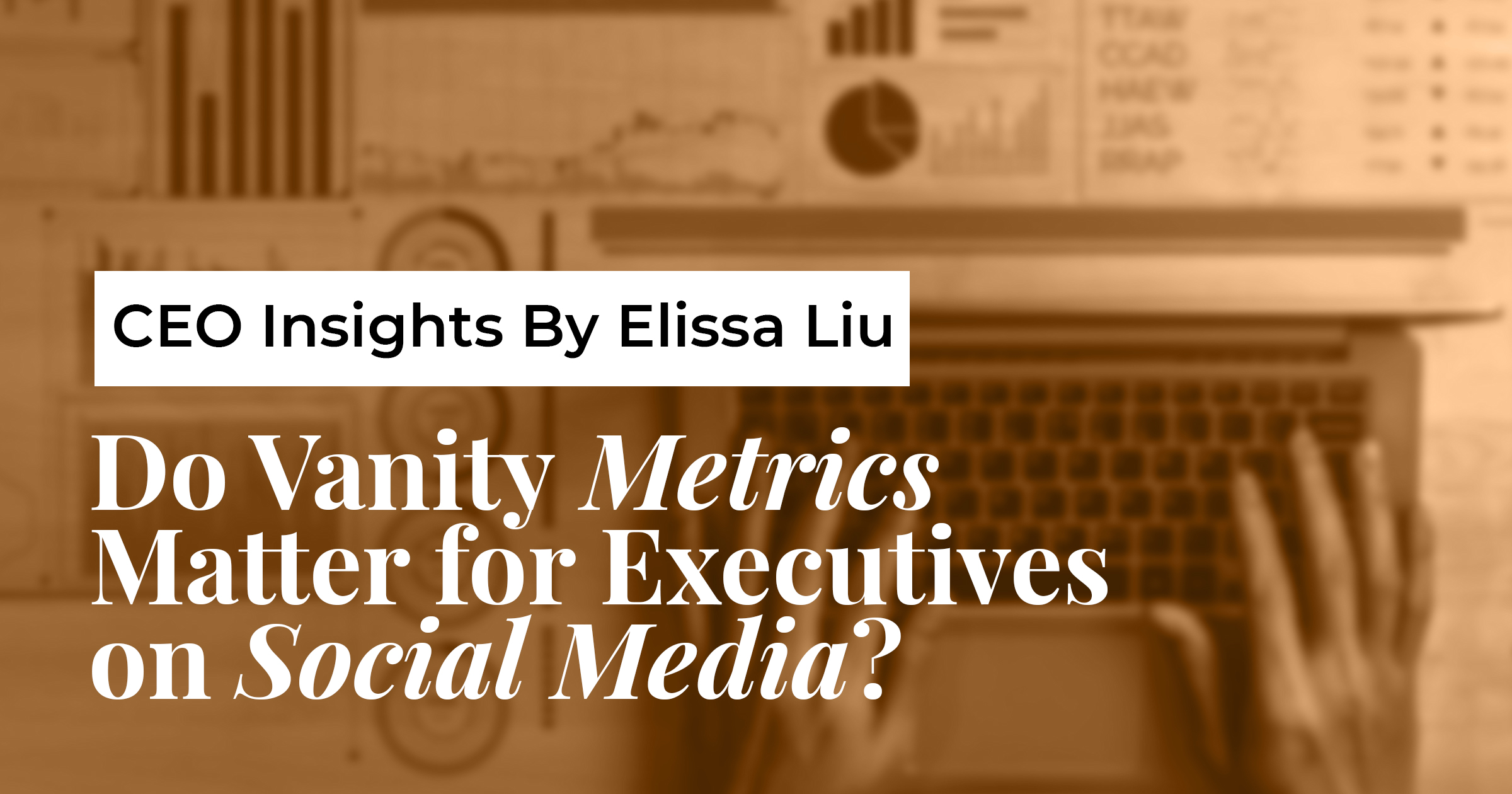For executives on social media, do vanity metrics, such as post “likes,” matter?
The answer is yes and no. Whether it’s a heart on a Twitter post, a reaction on a LinkedIn article, or a thumbs up on a YouTube video, the importance of “likes” on an executive’s post depends on a number of variables.
For any social media program, whether it’s for a brand or an executive, I always place more emphasis on creating meaningful and relevant content, and tracking mid- to bottom-of-funnel metrics (e.g. traffic to site and leads generated) over time, ideally linking them back to various social media platforms and content pieces.
Engagement metrics, such as post likes, don’t always translate directly to other key metrics. Reactions on a Facebook post can’t tell us exactly how many people who engaged with the post ended up making a purchase.
However, that’s not to say that post likes aren’t useful to track. Achieving more likes on a post can be an indicator of how well an executive’s content is resonating with their audience. To improve the number of likes on your post, it’s important to understand other factors that may be impacting your content.
What type of content are you sharing on social media?
When dealing with a low number of likes, one of the first steps is to analyze the content you’re sharing on social media. Low content engagement often stems from:
- Content that doesn’t resonate with the executive’s current follower base
- Content that isn’t optimized for a particular social media platform, and therefore isn’t getting as many impressions as it should
- Content topics that are not a good fit for the social media platform
For executives who have been on social media for some time but have since transitioned to a more business-oriented content strategy, this can be jarring for their users who have been accustomed to a particular type of content. For example, if an executive typically posts about their personal life but then switches to posting about their company, the sudden shift in tone and content topic might lead to lower engagement rates. Seeing a dip in engagement metrics is a natural part of the process and is completely normal. This is often the case when the executive’s followers may be personal connections or lower quality followers that don’t align with their objectives. After content strategy has been shifted to drive towards business objectives, follower refresh (which is covered in the next section), can follow.
Next, content that isn’t optimized for a social media platform could have a lower reach, leading to lower likes on an executive’s post. This is one area many executives struggle with, particularly those who manage their own social media. Understanding how many and which hashtags to use, what time of day to post, and other best practices can be tricky when managing content creation on your own.
Lastly, certain types of content can be a natural fit for specific social media platforms, such as Instagram for more personal content where an executive can post about their hobbies. In contrast, a screenshot of a text-heavy Forbes article on Instagram might not get a lot of likes, but linking to the same article on LinkedIn could result in a better performing post.

Are you engaging in any social media follower growth?
A comprehensive executive social media presence goes beyond posting content and includes other activities to support the program’s objectives.
While it can be a time-consuming process, follower growth activities are aimed at increasing the number of relevant followers or connections related to the executive’s business goals. An example is engaging in LinkedIn outreach to build a network of connections within a specific industry that could potentially become future clients. This is an important method to ensure that an executive’s followers on social media align with their business objectives. When both your content and your follower base are aligned towards a specific business goal, you may start to see an increase in post likes since the content will be more relevant to them.
Follower growth isn’t just about sending out invitations. Another activity is actively being a part of the social media community. On LinkedIn, which our research shows most executives are on, this might include commenting on or sharing other posts. The benefit of being active on social media is that executives can extend their reach beyond their own content by showing up on other people’s posts.
What are your social media objectives?
Are engagement metrics, such as post likes, one of your main objectives? For executives who are establishing their thought leadership or are looking to be more influential through social media, post likes may be one part of the bigger picture.
For executives who are looking to increase brand awareness or drive traffic to their company’s website, post likes may be less relevant compared to content messaging and other metrics, such as link clicks.
If the number of likes on your post is important, there are ways to increase engagement, whether through organic or paid methods.
On some platforms, marketers can boost or promote an organic social media post. This puts the post in front of more eyes that might not normally have seen the content in their own feed. For example, boosting a post on Facebook means users who match your targeting parameters will see your content in their feed, even if they’re not following you. Since boosting a post costs money, executives should always refer to their social media strategy to determine whether or not a post should be boosted.
An example of an organic method to increase engagement rates is simply to ask users to like the post or leave a comment. When a post includes a CTA, or call to action, users are more likely to engage with the post. Depending on the content of your post, consider using CTA phrases like:
- Leave a like on this post if you agree!
- Comment below and let me know your thoughts.
- If you think this post was helpful, tag a friend and share it with them.
How strategic is your executive social media program?
Are you posting once every other day or once every other week?
For many executives on social media who are sharing content without an end goal in mind or without a strategy developed by their in-house marketing team or a partner marketing agency, this may lead to more inconsistent posting and content that results in lower reach and post likes.
On the other hand, we know that social media platforms reward users who are more consistent with their posting by showing the individual’s content more often on other people’s news feed.
While likes are easy to understand, what’s most important is whether or not it’s valuable to an executive’s online presence. Ultimately, if increasing engagement metrics are your goal, keep in mind that it may take time to build a follower base that aligns with your content, and consistently posting meaningful content is crucial.
There’s nothing wrong with wanting to improve vanity metrics, but the focus for any executive on social media should be on their main business objectives that their online presence is driving toward.


